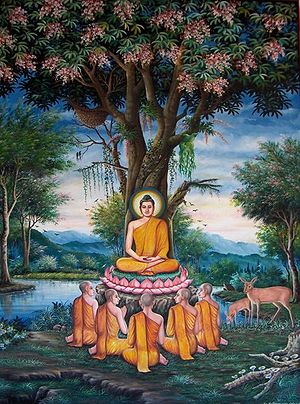Anatta “Not Self”
By Shelton Ranasinghe
Anatta
Just like Einstein discovered the general theory of relativity, over 2000 years ago the Buddha disclosed the “No Self” concept. This is remarkably an extra ordinary discovery. The people at that time did not know the function of the brain. Whether the Buddha understood the function of the brain is not known as there is no reference to the brain in his teachings. However through self evaluation of how the mind process works he disclosed this fact. The function of the brain was understood in the very recent time, about 300 years ago. The Buddha had thousands of disclosures during his life time. The discovery of “No Self” concept was so important to the Buddha that he prioritized this disclosure to be his second sermon and named it as Annattalakkhana-sutta. The “Anatta” (meaning “Not Self”) doctrine is presented through this sutta. This sutta very deeply explains the philosophical aspect of self. This specific topic of teaching stands out uniquely in the world of religions as all the other religions believe in a self or soul.
The Buddha explained that there is no personality as self or soul. What we experience as self is an illusion, imaginary mental projection, a false belief and non reality. The sense of self only seems solid, but this is in fact an illusion. The true nature is something else entirely. The man attains enlightenment only when he overcomes the delusion of self.
The doctrine of impersonality (Anatta) was very controversial even at the time of Buddha. It is complicated to understand though many books have been written by various scholars based on their understanding. The Buddha stated very clearly that “All ‘Dhammas’ are without self”. “Dhammas” include conditioned things (ex. Samkhara – mental elements and formations) as well as non-conditioned things (ex. Nirvana – State of enlightenment). Though the Buddha vehemently rejected the “soul” theory that was popular at his time, on various occasions he did not openly attack the other religious leaders who preached the soul theory. Attack was not the strategy of his mission. The dialogue Buddha had with disciple Ananda after being silent on the famous question asked by Vacchagotta on “Self”, is a well known recorded incident in Buddhist scriptures. In this particular dialogue the questions were directly associated with the two streams of definitions given for soul at that time. One stream was the belief in a permanent soul, transmigrating from one life period to another. The other was about the soul that only confined to the existing life period.
To explore the understanding of “Anatta”, it is good to know how the Buddha explained the two categories of truths. These were “Conventional truth” and “Ultimate truth”. In day-to-day life most of the things we perceive can be categorized as conventional truth. A few examples are following. We perceive our earth as flat. That is the conventional truth, but it is not really flat. We know that an atom is over 99% hollow, because the electrons circle around the nucleus of the atom are at vast distances compared to the size of the nucleus of the atom. We are made of atoms. Hence we must be over 99% hollow. But we do not define our body that way. White light is made of seven colors but we do not see them separately. Hence, there are conventional truths and ultimate truths as indicated. In everyday life we refer to both these streams for the purpose of understanding and explaining things. If people try to be absolutely specific or scientific in selecting words, we will run into problems in communicating to each other. The self exists as a conventional entity but not in the sense of ultimate truth. “Anatta” has to be evaluated in the context of the ultimate truth and if one tries to explain it in the context of conventional truth it would be a failure.
In all world religions other than in Buddhism, there is a clear belief of a soul that carries the ownership of self from one life to another. As explained in many religious scripts the soul gets punished or rewarded through its journey and is eligible to end up in the kingdom of God, in a place called heaven. In Hinduism the soul can end up in heavenly worlds and also it could be worked out to achieve “Moksha” which is defined as the freedom from the cycle of birth. A soul of a person who has achieved the state of Moksha is supposed to be joining the ultimate flux of energy after death where everything defined to have originated from. In great books of Hinduism, the subject of self is characterized in association with two facets of entities namely the “Nama” (Soul or Atman) and “Rupa” (body). Hindu teaching is very much like the Buddhist teachings in many respects and hence it is interesting to understand the marked difference between the two ideologies in respect to the definition of soul. In Hinduism the self can be explained around the following slogans: “You identify your body (nama), but you are not your body, your soul is the witness of your body; you identify your thoughts (rupa), but you are not your thoughts, your soul is the witness of your thoughts; you identify your emotions, you are not the emotions, your soul is the witness of your emotions”. As phrased above, the self or the soul is directly correlated to a witness with the “nama” and “rupa” concept. Buddha took a step further on this and explained that there is no “witness” either, to be defined as self. In other words there is no thinker of thoughts or a feeler of sensations or a receiver of reactions under the context of ultimate truth that was discussed earlier. Self is an illusion and a non-reality. At every moment there is a birth followed by a death and vice versa. Every instant is a momentary rebirth without a soul. The nature of this illusion is the crux of the Buddha doctrine disclosed by Annattalakkhana-sutta.
It is interesting to note that there are books written about out-of-body experiences. Leave alone the subject of out-of-body experience, if someone asks you to explain exactly where you are in a body (in-body), other than merely giving some references as an answer; there is no proper answer to come up with or to explain who you are. This is exactly what the Buddha pointed out by saying that self is an illusionary process that we have been fooled by. To explain this further, Buddha fragmented all elements which we perceive as self and pointed out that all those fragments are ever changing entities. Either none of them or any combination of them or all of them, can be defined as self as ascribed in soul theory. To explain what people believe as self, the Buddha talked about the five aggregates (Khandhas – piles). By talking about the five aggregates Buddha did not define self as the five aggregates but acknowledged that it is what people considered as self. The five aggregates are defined as form, feeling, perception, fabrication and consciousness. Buddha explained that either none of those aggregates or any combination of those or all of those does not constitute a self. The fragmentation study of self and the dynamism of our existence are further expounded by the Conditioned Genesis (Paticca-Samuppada) in Buddhist teachings. Conditioned Genesis is a law of conditionality based on the following formulation.
“When there is this, that comes to be.
With the arising of this, that arises
When there is not this, that does not come to be.
The ceasing of this, that ceases”
Buddha derived the following fragmented logic elements by applying “Paticca-Sampuppada” to the dynamism of our existence.
1. Conditioned by Ignorance, Intentional activities arise
2. Conditioned by Intentional activities rethinking Consciousness arises
3. Conditioned by Consciousness, Mind and matter arise
4. Conditioned by Mind and matter, the six fold base arises
5. Conditioned by the six fold base, Contact arises
6. Conditioned by Contact, Feeling arises
7. Conditioned by Feeling, Craving arises
8. Conditioned by Craving, Grasping arises
9. Conditioned by Grasping, Becoming arises
10. Conditioned by Becoming, Birth arises
11. Conditioned by Birth, aging, death, sorrow, pain, grief and despair arise.
This explains the process of all elements associated with life. It is to be considered as a cyclic process. Some scholars explain this formulation as cyclic as well as a complex interwoven network process. It touches the birth and death elements. It is a “cause and effect” theory. For example, say that you have craving to buy a luxury car. That craving, ultimately results in an arising of grief when you are unable to buy it. As long as you have the car in your mind the logical elements from 1 to 11 given above keep on forming as a cyclic stream. The simple meanings of the two Pali words in the context of the computer model discussed earlier translate as “Influences (Paticca) of Inputs (samuppada)”.
Buddhist scripture states – “The foolish man conceives the idea of self, the wise man sees there is no ground on which to build the idea of self. Acceptance of the truth of the impermanence of self and the world will therefore free a man from much suffering, if he only makes the effort”.
If self is an illusion, the question arises as to “who” gathers or receives the Karma or the resultant reactions (conventional merits and demerits associated with actions) associated in most of the eastern religions. The soul theory in Hinduism perfectly answers this question as it recognizes a transmigrating entity. Most Buddhists tend to grasp the soul theory inadvertently as a result of this. Acceptance of soul theory contradicts the Buddhist teaching. Buddha pointed out the in-validness of the above question. Because, since there is no self or soul, the word “who” does not bear any validity or meaning in the question of “who” gathers or receives the Karma. Because the question is not valid, an answer cannot be composed. Self is an illusion. This non-self theory puts a spin onto operational logic of rebirth and Karma concepts. Rebirth and Karma concepts existed prior to the Buddha era, and were integral parts of Hinduism, and became elements of Buddhist doctrine as well. However Buddha’s explanation of the Karma and rebirth theory is not soul based and shall be understood in that respect.
Shelton Ranasinghe
Author: Buddha Impetus to Primitive Psyche, Heaven at SETI’s Doorstep
Shelton Ranasinghe
B.Sc (Eng), C.Eng, P.Eng, MIMech E(London), MIE(Australia), FIE(Sri Lanka), ASME(USA)
Author of Buddha Impetus to Primitive Psyche and Heaven at SETI’s Doorstep
Article Source: http://EzineArticles.com/?expert=Shelton_Ranasinghe
http://EzineArticles.com/?Anatta-Not-Self&id=6817142
Related articles
- How Buddhism Began by Richard F. Gombrich (buddhistbooksblog.wordpress.com)
- What the Buddha Taught by Walpola Rahula (buddhistbooksblog.wordpress.com)
- A Way of Life for All Time (buddhistpost.wordpress.com)
